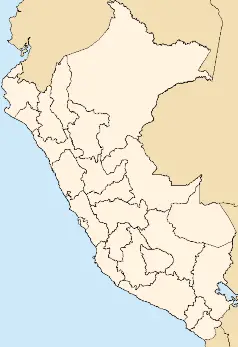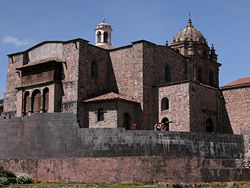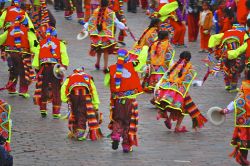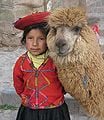Cusco
- This article is about the city in Peru. For other uses of the term, see Cusco (disambiguation).
| ||||||||||||||||||||||||||||||||||||||||||
| ||||||||||||||||||||||||||||||||||||||||||
Cusco (also spelled Cuzco, and in the local Quechua language as Qusqu IPA: ['qos.qo]) is a city in southeastern Peru, near the Urubamba Valley (Sacred Valley) of the Andes mountain range. It is the capital of the Cusco Region as well as the Cusco Province. Cusco is the historic capital of the Inca Empire.
Geography
After the arrival of the Spanish conquistadors, the Quechua name ("Qosqo") was transliterated into Spanish as "Cusco", which is how it appears on maps from the 17th and 18th centuries.[1][2] On maps from the 19th century (as early as 1810[3][4]) and through the mid-20th century (until at least 1976), the name appears as "Cuzco". Today, in official Peruvian cartography (in Spanish) the name has returned to the original transliteration: Cusco, with an S rather than a Z.
Located on the eastern end of the Knot of Cusco, in the southern highlands, its altitude is around 10,800 feet (3300 meters).
Cusco's temperature is relatively consistent year-round, with average maximum daytime temperatures of 70°F (21°C), with July minimums of 30°F (-1°C). Usually, it is cold at night and the temperature increases considerably until noon. The rainy season goes from November to March, and the dry season goes from April to October.The average annual precipitation is 32 inches (812mm).
Cusco was found in 2006 to be the spot on Earth with the highest ultraviolet light level.[5]
Rivers and canals
Size – land area, size comparison
Environmental issues
Districts
History
Killke culture
The Killke occupied the region from 900 to 1200 C.E., prior to the arrival of the Incas in the 1200s. Archaeologists discovered, on March 13 2008, the ruins of an ancient temple, roadway and irrigation systems at Sacsayhuaman, a famed fortress overlooking the Inca capital of Cuzco. Previous carbon-14 dating of Sacsayhuaman revealed that the Killke culture constructed the fortress in the 1100s.[6] In 2007, excavations uncovered another temple on the edge of the fortress, indicating religious as well as military use of the facility.[7]
Inca history
Cusco was the capital of the Inca Empire (1200s-1532). Many believe that the city was planned to be shaped like a puma. The city had two sectors: the urin and hanan, which were further divided to each encompass two of the four provinces, Chinchasuyu (NW), Antisuyu (NE), Qontisuyu (SW) and Collasuyu (SE). A road led from each of these quarters to the corresponding quarter of the empire. Each local leader was required to build a house in the city and live part of the year in Cusco, but only in the quarter of Cusco that corresponded to the quarter of the empire in which he had territory. After Pachacuti, when an Inca died his title went to one son and his property was given to a corporation controlled by his other relatives (a process called split inheritance), so each title holder had to build a new house and add new lands to the empire, in order to own the land his family needed to maintain after his death.
According to Inca legend, the city was built by Sapa Inca Pachacuti, the man who transformed the Kingdom of Cusco from a sleepy city-state into the vast empire of Tahuantinsuyu. But archaeological evidence points to a slower, more organic growth of the city beginning before Pachacuti. There was however a city plan, and two rivers were channeled around the city.
The city fell to the sphere of Huáscar in the division of the after the death of Huayna Capac in 1527. It was captured by the generals of Atahualpa in April 1532 in the Battle of Quipaipan, and nineteen months later by the Spaniards (see battle of Cuzco).
Post-Columbian Cusco
| “ | We can assure your majesty that it is so beautiful and has such fine buildings that it would even be remarkable in Spain. | ” |
The first Spaniards arrived in the city on November 15 1533. Spanish conquistador Francisco Pizarro officially discovered Cusco on March 23 1534, naming it the "Very noble and great city of Cusco". The many buildings constructed after the Spanish conquest are of Spanish influence with a mix of Inca architecture, including the Santa Clara and San Blas barrios. The Spanish undertook the construction of a new city on the foundations of the old Inca city, replacing temples with churches and palaces with mansions for the conquerors. During the colony, Cusco was very prosperous thanks to the agriculture, cattle raising, mining as well as the trade with Spain. This allowed the construction of many churches and convents, and even a cathedral, university and Archbishopric. Often, Spanish buildings were juxtaposed atop the massive stone walls built by the Inca.
A major earthquake in 1950 badly destroyed the Dominican Priory and Church of Santo Domingo, which were built on top of the impressive Coricancha (Temple of the Sun). The city's Inca architecture, however, withstood the earthquake. Many of the old Inca walls were thought to have been lost after the earthquake, but the granite walls of the Coricancha were exposed, as well as many walls throughout the city. While some wanted to restore the buildings to their colonial splendor, a contingent of Cusco citizens urged city officials to retain the exposed walls. Eventually they won out. Cusco was also hit by a major earthquake in 1650.
Government
Peru is a constitutional republic. The president is both the chief of state and head of government, and is elected by popular vote for a five-year term, being eligible for a nonconsecutive reelection. The unicameral Congress of the Republic of Peru has 120 members elected by popular vote to serve five-year terms.
Cusco is the capital of the Cusco region, and of the Cusco province, one of the region's 13 provinces. which are composed of 108 districts (distritos, singular: distrito).
Economy
Abundant mineral resources are found in Peru's mountainous areas, and coastal waters provide excellent fishing grounds. However, overdependence on minerals and metals subjects the economy to fluctuations in world prices, and a lack of infrastructure deters trade and investment.
Per capita GDP, rank Financial and business services sector Tourism Manufacturing
The surrounding Huatanay Valley is strong in agriculture, including corn, barley, quinoa, tea and coffee and gold mining.
Transport: Road, rail, air, sea
Demographics
The city had a population of 348,935 in 2008, which is triple the figure of 20 years earlier.
Amerindians made up 45 percent of the population in 2003, mestizo (mixed Amerindian and white) 37 percent, white 15 percent, black, Japanese, Chinese, and other 3 percent.
Spanish and Quechua are the official languages, while Aymara and a large number of minor Amazonian languages are spoken in Peru.
Roman Catholic make up 81 percent of the population, Seventh Day Adventist 1.4 percent, other Christian 0.7 percent, other 0.6 percent, while 16.3 percent had either an unspecified or no religion. in 2003.
Colleges and universities
Of interest
The original Inca city, said to have been founded in the 11th century, was sacked by Pizarro in 1535. There are still remains, however, of the palace of the Incas, the Temple of the Sun and the Temple of the Virgins of the Sun. There are still Inca building remains and foundations, which in some cases have proved to be stronger than the foundations built in present-day Peru. Among the most noteworthy buildings of the city is the cathedra of Santo Domingo.
The major nearby Inca sites are Pachacuti's presumed winter home, Machu Picchu, which can be reached on foot by a Inca trail or by train; the "fortress" at Ollantaytambo; and the "fortress" of Sacsayhuaman.
Other less-visited ruins include: Inca Wasi, the highest of all Inca sites at 3,980 m (13,134 ft); Old Vilcabamba the capital of the Inca after the capture of Cusco; the sculpture garden at Chulquipalta (aka Chuquipalta, Ñusta España, The White Rock, Yurak Rumi); as well as Huillca Raccay, Patallacta, Choquequirao, Moray and many others.
Thanks to remodelling, Cusco's main stadium, Estadio Garcilaso de la Vega, attracted many more tourists during South America's continental soccer championship, the Copa América 2004 held in Peru. The stadium is home to one of the country's most successful soccer clubs, Cienciano. Cusco's local team has made a name for itself in the world of club soccer, as it has won several international competitions in South America, although it has yet to achieve such success in its home country. Nonetheless, it is still considered to be one of the best teams in Peru. The team is strongly supported throughout Cusco; men without a set at home will stand in the street and watch the game on televisions in shop windows. Tickets are sought-after and buying them entails long queueing.
The city is served by Alejandro Velasco Astete International Airport.
Food
As headquarters to the Inca Empire, Cusco was an important agricultural region and a natural reserve for thousands of native Peruvian species, including hundreds of potato varieties.[citation needed]
More recently, thanks to Peruvian and foreign cooks, Cusco has begun to offer many fusion and neo-Andean restaurants in which the cuisine, prepared with modern techniques and incorporating a blend of traditional Andean and international ingredients, delivers an innovative, exciting dining experience.[8]. Cusco is one of the Andean cities in which visitors can taste many spices, of different origins, and agricultural produce, mostly organic, treated and grown in environmental friendly and traditional ways,[citation needed] frequently using ancient techniques such as the "Chaquitaclla" (foot plough).[9].
Industry
- Cusqueña brewery
Gallery
- Cusco-plaza-c04.jpg
Plaza de Armas
- Piedra de 12 angulos.jpg
Twelve-angle rock
- Cuzco001.jpg
Plaza de Armas
- Iglesia-La-Compania---Cuzco.jpg
The Church of La Compañia on the Plaza de Armas
Notes
- ↑ Ianssonium, Ioannem (1647) Mapa del Perú, image in Wikipedia Commons
- ↑ Bellin, Jacques Nicolas (1758) Suite du Perou Audience de Charcas Paris, France, image in Wikipedia Commons;
- ↑ Pinkerton, John (1810) "Peru" World Atlas Cadell and Davies, London, image in the David Rumsey Map Collection;
- ↑ Carey, Mathew (1814) "Peru" World Atlas Mathew Carey, Philadelphia, image in the David Rumsey Map Collection;
- ↑ Liley, J. Ben and McKenzie, Richard L. (April 2006) "Where on Earth has the highest UV?" UV Radiation and its Effects: an update NIWA Science, Hamilton, NZ;
- ↑ Pre-Inca temple uncovered in Peru - CNN.com
- ↑ NEWS - Comcast.net
- ↑ Guide to Peruvian Food, Cusco Reference
- ↑ chaquitaclla - Britannica Online Encyclopedia
Further reading
- Inca road system
External links
- Encyclopaedia Britannica Cusco Retrieved September 6, 2008.
- World Fact Book 2008 Peru Retrieved September 6, 2008.
- PromPerú: Government Tourism Site
- Cusco at Google Maps
- Cusco GPS map
- Travel guide
- Tourist guide at Wikitravel
- Photos of Cusco and the Sacred Valley
- Photos Sacsayhuaman at Pasaporteblog.com {es}
Credits
New World Encyclopedia writers and editors rewrote and completed the Wikipedia article in accordance with New World Encyclopedia standards. This article abides by terms of the Creative Commons CC-by-sa 3.0 License (CC-by-sa), which may be used and disseminated with proper attribution. Credit is due under the terms of this license that can reference both the New World Encyclopedia contributors and the selfless volunteer contributors of the Wikimedia Foundation. To cite this article click here for a list of acceptable citing formats.The history of earlier contributions by wikipedians is accessible to researchers here:
The history of this article since it was imported to New World Encyclopedia:
Note: Some restrictions may apply to use of individual images which are separately licensed.







